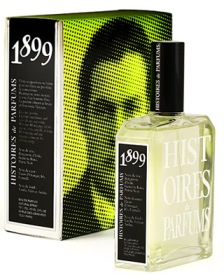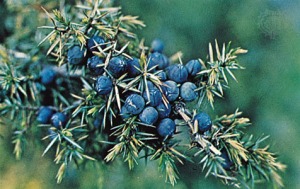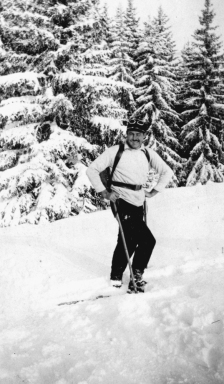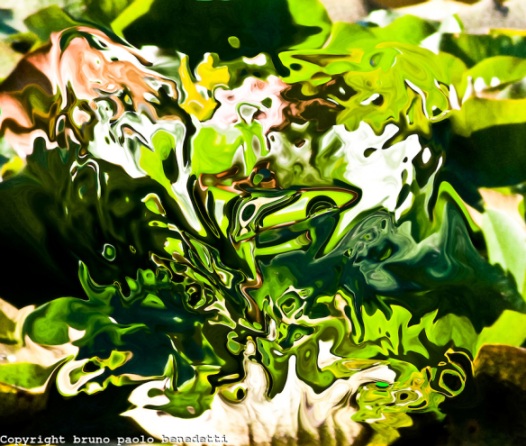1899 is the year of Ernest Hemingway‘s birth, and also the name of the newest fragrance from Histoires de Parfums, a French niche perfume house founded by Gérald Ghislain. It is a company whose perfumes are often entitled simply with a date in history, the year in which a legendary figure was born. This fall, they tackled Ernest Hemingway. I absolutely loathe the man for his personal life and character, but I was intrigued by how his essence might be encapsulated on an olfactory level. So when I saw a bottle of 1899 while visiting Jovoy Paris, I eagerly tested it on paper. My initial impression was far from favorable, but scented strips rarely tell an accurate tale, so I asked for a sample. I thought things might change upon a proper test. They did not, in large part. While I now see more to 1899 Ernest Hemingway than I did then, I’m still not particularly enthused.
1899 is the creation of Gérard Ghislain, and is an eau de parfum. Histoires de Parfums’ full description for the scent, along with its notes, is as follows:
The top notes of Italian bergamot, juniper and pepper are intended to be the aperitif that sparks the conversation and awakens the palate in anticipation of the meal. Following “Papa” from Spain to Italy with Mediterranean scents that evaporate to leave place to a darker mood, where the amber and vetiver mixed is reminiscent of the waxed wood of a Cuban bar top. The exotic meets the familiar, the tropical heat is cooled off by a glass of scotch.
Top Note: Italian bergamot, juniper, black pepper
Heart Note: Orange blossom, Florentine Iris, Cinnamon
Base Note: Vanilla, Vetiver, amber
1899 Hemingway opens on my skin with a cocktail of salty sea crispness and hesperidic citrus freshness. First and foremost is juniper, yielding a green, pungent, pine-y, very outdoorsy aroma. It is infused with fruits, perhaps from actual juniper berries themselves, but also with crisp, lemony bergamot. I tested 1899 three times and, on the last occasion, juicy oranges were also quite noticeable, adding a fruited, sweet touch to juniper’s foresty, green, spicy, peppered aroma. Seconds later, black pepper, green vetiver, and a touch of floral iris join the mix.
1899 Hemingway has the initial profile of a very masculine cologne, but with greater heft and less thinness in its body. It is a profile that I struggle with, if I am honest. Juniper is not something that will make me jump up and down in ecstacy, and neither do black peppercorns or iris. Still, it’s a very rugged, outdoorsy, masculine aroma and I can see why they chose it for Hemingway.
Five minutes in, other elements become noticeable. Hints of orange blossom flit about with a slightly bitter, dark, pungent and piquant undertone that resembles neroli more than any indolic, lush, white floral bomb. In 1899’s depths, the vanilla slowly starts to stir. Up top, the vetiver becomes much more pronounced. It’s not earthy, damp, and rooty at all. Actually, when combined with the sharp, fresh citruses and the piney, almost cedar-like aroma of juniper, the vetiver feels very green. To me, the three notes together create the mineralized accord of the vetiver in Terre d’Hermès, only with a much more Alpine feel. During his first marriage, Hemingway went often to Switzerland, and there is something of that clean, fresh, crisp mountain air in 1899. You can almost see the vast forests of Switzerland before your eyes, only these are not snowy but dotted with orange and lemon trees as well.
1899 is a very well-blended fragrance that doesn’t always develop in the exact same manner. In my three tests, some of the notes varied in strength or in the order of their appearance. Take, for example, the iris. During my first test, it was barely a factor for most of 1899’s lifespan, popping up only occasionally at the perfume’s edges but without any substantial heft whatsoever. In my second test, it was quite pronounced in the end, adding a powdery touch to the perfume’s sweet final stage. In my third one, however, the iris suddenly appeared noticeably right from the start, adding its floral coolness to the Alpine meadows. Another note that seemed to vary in its character was the orange blossom which consistently seemed more fruited than floral, except the first time around when it manifested itself in both ways.
Nonetheless, 1899 does have some uniform aspects to its development. About 10 minutes in, the fragrance turns warmer and starts to lose its cologne-like sharpness. A touch of cinnamon appears, the amber awakens from its slumber, and the vanilla starts its slow rise to the surface. Warmth and sweetness slowly start to creep over 1899, like a wave inching up a sandy beach. The amber, vanilla and cinnamon may not be noticeable in any profound, individual way, but they have an indirect effect on the other notes. They make the orange blossom lose some of its piquant, bitter, neroli-like undertone, and soften the sharpness of the juniper, while adding a touch of spice. At times, the overall effect is almost like Viktor & Rolf‘s Spicebomb, but not quite.
Suddenly, 25 minutes in, the warm notes flood the surface and 1899 changes into a much different fragrance. Gone is the purely cologne-like scent with its crisp, citrus, woody, masculine profile. Now, there are oriental and floral touches. First up is the orange blossom which stops feeling purely like a ripe, juicy, sweet fruit, and more like the actual white flower. It adds a sensuous touch to Hemingway’s face, like a warm, seductive caress across his unshaved whiskers redolent of his woody, piney, vetiver, lemon aftershave. While the main note remains the peppery, spicy juniper, it’s now been infused with cinnamon and amber as well.
1899 Hemingway’s shift is complete at the 40-minute mark when the vanilla bursts onto the scene like a white bull running into a Pamplona arena. From Switzerland, we’ve suddenly landed in Spain where Hemingway spent so much time in the 1930s. The land of Seville oranges, orange blossoms, groves of green, dry warmth, and languid sensuality — it’s all here, under the top layer of rugged, outdoorsy juniper-lemon cologne. I know Histoires de Parfums gives the perfume’s geographic trajectory as Spain to Italy to Cuba, but I’m sticking with Switzerland to Spain, with crisp Alpine forests taking on a more Mediterranean sensual warmth. I have to say, I find the olfactory symbolism quite impressive on an intellectual level.
I just wish I liked the actual smell. For me, the opening was too much like cologne, but uninteresting cologne. The juniper was too sharp and turpentine-like at times, and didn’t even have the appeal of a gin-and-tonic. I liked even less 1899’s new combination of vanilla with crushed juniper needles, trailed closely by cinnamon, then by orange blossoms, oranges, lemons and amber. Honestly, it made me feel queasy, each and every time. Something about the combination felt cloying in its sweetness, somewhat odd in its polar opposite parts, and simply not appealing at the end of the day. Perhaps I’m simply not a fan of juniper mixed with vanilla, gooey oranges, unctuous orange blossoms, and cinnamon. It is the main profile of 1899 Hemingway for hours and hours, and I really wanted it to stop.
1899 Hemingway brought to mind two other Histoires de Parfums’ scents, but for very different reasons. Like many from the line, the fragrance is not revolutionary or edgy, but has a gracefulness about it — regardless of whether you like the notes or not. Like its siblings, 1899 is potent at the start, while also being incredibly airy in weight and very well blended. In that way, it resembles Ambre 114. Yet, at its core, 1899 is thematically quite close to 1725 Casanova in its transition from masculine to soft, unisex, and almost gourmand in nature. It’s that powerful vanillic base that both fragrances share, after a very crisp start. However, 1899 is significantly more masculine in my opinion, even at its end, thanks to the woody juniper. 1725 Casanova is smoother, more truly unisex with its lavender, more gourmand at its base, and much better balanced in my opinion. It never felt cloying, or a war of extreme, opposite notes.
That brings me to what may be my fundamental issue with 1899 Hemingway: it doesn’t know who it wants to be. It took me a while (and three tests) to suddenly realise that the perfume is trying to be all things to all people. It straddles so many different genres: masculine cologne, oriental, woody outdoorsy, gourmand, and many hybrid versions thereof. But it can’t seem to make up its mind. I don’t have a problem with the fact that Histoires de Parfums has made a fragrance with a commercial, mainstream character — some people on Fragrantica think that 1899 is like Spicebomb — but I struggle with the perfume’s fragmented, confused identity. Perhaps that makes it very Hemingway after all; the writer was known to be a complex set of contradictions with a highly insecure, sometimes utterly neurotic side. (I am trying so, so hard to be polite about the man!)
Getting back to the perfume’s development, there really isn’t a lot more to say. Until its end, 1899 remains a scent that is primarily vanilla, juniper and some form of orange (or orange blossom) infused with a hint of cinnamon, all atop an amber base. At the 1.5 hour mark, its sillage drops, the perfume feels thinner, its edges blur, and the notes are not easily separable in a distinct, individual way. Three hours in, 1899 hovers just barely atop the skin. The sillage isn’t impressive as a whole with 1899 unless you apply a lot. Eventually, 1899 Hemingway fades away in some sort of sweetness and with an average lifespan of about 7.5 hours.

“Shades of Leaves,” abstract photography by Bruno Paolo Benedetti. Source: http://imagesinactions.photoshelter.com/gallery-image/abstract-impressionist-photography/G0000LzIQxYEISEo/I0000rdtpLoFmVPU
The very end, however, seems to differ in terms of its olfactory specifics from wearing to wearing, perhaps as a result of the quantity applied. In one test, using 3 average sprays from the small atomizer, 1899 ended just after 7 hours in a blur of woody, juniper and vanilla. In another test, using 2 tiny sprays, it took a mere 6 hours for 1899 to die, ending in a powdery, floral, iris-y vanilla blur. In my last test, using 4 big sprays, 1899 lasted longer, just under 9 hours, before fading away with orange-y sweetness and nothing else. The atomizer’s hole is very small, so the quantity applied is probably much smaller than from an actual bottle. It would probably range between 1.5 big smears from a dab vial to about 4 very small, narrow ones.
1899 Ernest Hemingway is too new for there to be comparative reviews that I can show you. The fragrance’s Basenotes entry (on the old Huddler Archive) doesn’t have any comments from those who have tried it. Fragrantica‘s early discussion thus far seems to focus on the extent to which it is like Spicebomb. Some think it’s a much better version. One person (“deadidol“) thinks 1899 Hemingway is well-done, but largely a bore. I agree with parts of his assessment:
More often than not, this brand misses the mark for me, and Hemingway’s a bit of a snooze. When HdP step outside they box, they truly innovate, but too many of their scents strike me as pleasant, run-of-the-mill affairs that are solid value for money, but aren’t contributing anything new. This is a mildly boozy oriental with a powdery iris note and a hefty amount of spices. There are some floral undertones that are met with a dry fruit note to spin the scent as opulent, but it’s linear and doesn’t really do anything to distinguish itself from the more powdery offerings of Dior, ByKilian etc. Also, the connection to Hemingway is a total mystery as there’s nothing rugged, troublesome or even narratalogical at work here, and it’s certainly not very masculine or virile. With that said, it’s a practical addition to the line as it’s big and amiable, bearing notable similarities to Bois d’Argent, but it’s not going to have much appeal for those who are hoping for another Petroleum, Marquis de Sade, Ambrarem, or Ambre 114. Durable and great value (another one of HdP’s strong points), but ultimately too pleasant, too powdery, and too prosaic.
I think 1899 Hemingway is much more rugged and outdoorsy than he does, but I do agree that the fragrance is merely a pleasant, “run-of-the-mill” scent with some “amiable” features. Just how amiable will depend on what you think of the central juniper note, and its interaction with the vanilla and spices. It’s not my cup of tea.
Nonetheless, I have to agree with another Fragrantica commentator in giving kudos to Histoires de Parfum for avoiding the usual, traditional clichés about Hemingway. It would have been all too easy to make a fragrance centered on cigars and rum. And, in my opinion, the company has actually succeeded in encapsulating parts of Hemingway’s life and contradictory character. They’ve created a perfectly pleasant fragrance that will probably be very sexy on some men’s skin. Unfortunately, I find it hard to sum up enthusiasm for more than that.










Bergdorf in New York also had this, and they were pushing it heavily the day I visited. Like you, I find HdP a bit mercurial in its offerings, and they’re often very hit-or-miss. When they hit, it’s an excellent outcome, but the extreme opposite was true when I tried this — it didn’t strike me as interesting as other offerings. I respect them for doing very unique releases, but only one of their offerings has made into my collection.
As usual, excellent review…and you are far from the only one who thinks Hemingway is over-rated.
First, it’s lovely to see you, my dear Suburbanites! Second, thank you for sharing your perspective on 1899. (I’m looking forward to getting to know your tastes better.) Like you, I respect the brand, but it seems that they were trying to do something more…. approachable??…. perhaps with 1899. I don’t think it has the crazy, wild intensity of Marquis de Sade or the unusualness of Tubereuse 3 Animale, for example. Then again, their line wasn’t always totally funky and quirky — witness Ambre 114 and 1725 Casanova. Which one of the HdP lines finally tempted you enough to buy?
BTW, another person who isn’t crazy about Hemingway??! I think that makes 3 of us here at the blog. We can carve out our own tiny corner of literary rebels. 😉 😀
As a child I liked Hemingway’s books (I read them in translation). The only his book I read in English was the one that was published after his death. I thought it was a bad idea. I do not know much about him (and do not care to) but the idea to name perfumes after known people doesn’t resonate with me so I won’t be looking for this perfume because of that and not because of the person. Though I should say that in your description, Kafka, it sounds like something I might like. I’ll try it when I come across it.
I’ll be curious to see what you think of it, Undina. I also wonder if you may just prefer it on your vSO instead. As for Hemingway, it’s better that you stay in ignorance as to his character/life, and just continue to love his books. lol. 😉
I was looking forward to trying HdP 1899. I even bought (yes!) a sample of it. I find it really nice but 1725 will be still my favorite one from the line.
Just like you I found the scent to have some similarities with 1725.
I’m glad you’re enjoying it, Lucas, but I can easily understand why 1725 would remain your favorite from the line. It’s very nice indeed.
I also like Rosam, but it’s a little bit too expensive for my budget
I have a sample of Papa’s fragrance which I have yet to test. I have not been eager to do so since HdP’s to me are underwhelming (plus I hate their bottles). A review, may or may not be coming in the future my dear K.
You’ll have to let me know what you think of it, official review or not. I’ll be curious to see if your reaction to 1899 is in line with your general lack of enthusiasm, or if it’s even more negative…. 😉
Knowing too much about authors is fatal. Just like actors. I wish they’d shut up and do their jobs. *g*
I’ve never been a Hemingway fan- to me he’s totally overrated and boring. And his personal life- the less said the better. I’d much rather see an Elizabeth Bennett perfume, or Marianne Dashwood. Jane Eyre. Something interesting.
OH, Jane Eyre!!!!!!! A Jane Eyre or a Mr. Darcy perfume would be fantastic! I’d definitely run out to try/sniff one of those! As for Hemingway, yes, most definitely, the less said about his personal life, the better.
For Jane you’d want something innocent, but with mystery. Darcy- I think you’d start with a classic scent, then give it a twist.
For Darcy, I think one needs top notes that are very cold, aloof, distant and haughty. A very cold chypre or icy carnation scent, I think. Then, a heart of warmth and sweetness, so an oriental with plushness and a touch of cozy, comforting custardy vanilla perhaps. LOL, this is fun. 🙂
That sounds lovely- I’d wear it!
Eh, this sounds so blah to me! I appreciate you taking the time to review it, though, as I was curious about it. I didn’t have super high expectations, and it seems to me like it would be a general disappointment for me. I really adore the line and like most everything I’ve smelled from them (some more than others, though). I suppose I’ll skip this one and await their next offering. I’ll certainly be curious to see where their next inspirations lie.
It is Blah as compared to the particular scents that I know you adore and own from HdP. Those have real character and are distinctive. 1899 Hemingway? Not so much. It’s fine, and worth a passing sniff if you’re actually near a bottle, but more than that? Not in my opinion.
Eeeks, this sounds like it could appeal to me. I’ll need to stop by Bergdorfs at some point in the next few weeks (I still have to go through that JAR experience).
Speaking of Hemingway, and of course this was 18 years ago, I recalled that one of our very senior executives (2 heartbeats away from the Chairman) had an original pencil drawing of Hemingway hanging in his office…chances were that he picked it out himself from the company’s extensive art collection — I never saw what was appealing about Hemingway nor the artwork itself.
I have the 15ml travel spray in a trio with Moulin Rouge and Blanc Violette. Because I wore one or the other of the more feminine fragrances while my husband wore Hemingway, my impressions of the perfume changed like yours did.
In neither of the wearings did I pick up white floral notes, except vaguely in the first wearing. Then the impression was dusty old barroom, and it was consistent. The juniper note is very woody, not herbaceous, and the second time it smelled a bit of gin martinis with lemon twist.
The second time, I wore Moulin Rouge, and he reapplied for dinner. Then I could see the Spice Bomb reference. The cinnamon and black pepper were very pronounced. Again, the effect was woody on the dry down, bone dry.
Thank you for sharing your experiences, Pearl Fingering.
I just reviewed 1899 Hemingway. I agree that it’s a bit inchoate, but I think the result is unique. I get candied vetiver more than juniper. The word that comes to mind is cute. It’s cute.
As for the author, I’m not a fan of minimalism but the few of his stories I read were melancholy. 1899 Hemingway is the opposite of melancholy; I found it downright foppish. The perfume doesn’t match the author. That kind of bothered me.
I’m glad it worked out for you, Joan. Candied vetiver sounds rather delicious, I must say, and definitely better than what my skin produced. 🙂
While the narrative nature of well constructed perfumes and literature may be related, biographies and portraiture seem a bit of a gimmicky stretch to me. That’s not a critique of the blend but more of an admission that I’m probably not a part of their target market.
I’ve sampled this twice, once lightly applied and once with a braver dose. Your description of its performance is spot on, as are is the notes summary. I learn so much from your note breakdowns. When lightly applied it was nothing beyond sweetly charming on my skin. A larger dose brought out a warmer, more gutsy masculine projection. Personally I liked the juniper, vanilla, cinammon chord with the play of florals along the way. It does what I wish the finer Dior scents like Bois d’Argent would do on me but don’t. 1899 kind of works on my skin, especially in dry cool weather. I will save my last sprays for around the winter holidays. It would be a nice scent for sitting around the woodstove sipping bourbon with friends. I can’t speak to its originality. I’m too much of a novice. I live in the country, however, and I could see it working for entertaining at home. At the moment, I’m not moved enough to purchase, but as the nights get colder I could be. Not a game-changer, but it’s not priced as one either.
Pingback: Masque Milano Hemingway - Kafkaesque